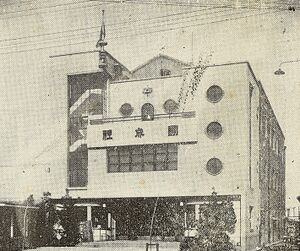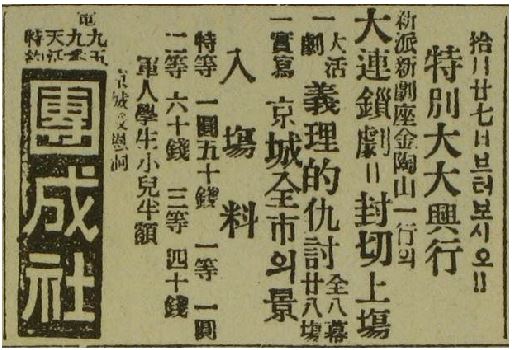Righteous Revenge (lost Korean kino-drama film; 1919)
Righteous Revenge (Korean: "의리적 구토"/"의리적 구투") was a 1919 Korean stageplay-film hybrid directed by Kim Do-san (1891-1921) and produced by Park Seong-pil premiered on October 27, 1919 at the Dansungsa theater in Keijō, Japanese Korea (now Seoul, South Korea).[1] Despite being considered the first film ever to be produced in Korea,[2] what makes it different to other films is that it was accompanied with a stageplay, which is known as a kino-drama.

Summary
No much is known about the plot, what is known is that the kino-drama centers around a character whose goal is to defend his father's inheritance from other family members and his stepmom.[4] The story was also considered as a symbolism for the Korean independence movement during the time Korea was part of the Japanese Empire.[5]
Availability
Despite the film being a success, with 100,000 tickets sold,[6] the film has no surviving footage and its script is lost.[7]
On June 1, 2024, a South Korean member of the Lost Media Wiki's Discord server under the username cheongsa7 managed to find more information of Righteous Revenge by an article about the kino-drama made by the Korean-language newspaper Cultura, with the following paragraphs:
Note: According to the translator, the English version might have some errors since the original text in Korean contains obsolete grammar and vocabulary.
Original
"장춘단에서 서빙고로 넘어가는 산 중턱에 어느 첫 여름날 흰옷 바람의 청중들이 마치 싸움이라도 구경하듯 빽빽이 들어차 있었다. 이들 군중의 시선은 저마다 포장을 젖힌 1915년식 포드 자동차에 쏠리고 있었는데, 그들이 유난히 눈여겨보는 것은 그 차에 타고 있는 세 명의 괴한이었다. 그들은 제각기 일본식 ‘합비’에 ‘당꼬 즈봉’을 입고 허리에는 번쩍거리는 장도(長刀)를 차고 있었다. 더욱 놀랍게도 백주에 가장행렬이라도 하는 듯 울긋불긋 분장을 하고 있었다. 괴한들이 산허리로 돌아가자 얼마 후 조금 떨어진 숲속에서 호각소리와 함께 청년 하나와 불란서제 목조촬영기를 멘 기사가 나타났다. 캡을 눌러쓴 사람은 일본인 카메라맨이었고, 얼굴이 거무잡잡하고 키가 작달막한 젊은 청년은 당시 단성사에서 명성을 떨치던 해설자의 원로 김덕경(金悳經)이었다. 덕경의 임무는 현장 지도와 통역이었다." [...] "무대에서 연극이 벌어지다가 등장인물이 급히 퇴장한다. 함께 연극하던 배우가 뒤따라간다. 이때 호루라기 소리가 나며 무대 위에서 옥양목 스크린이 내려오고 거기에 활동사진(영화)이 비춰진다. ‘아!’ 놀랄 새도 없이 방금 무대에서 본 배우들이 활동사진에서 연기를 한다. 쫓기는 자가 대기시켰던 자동차에 올라타고 질주한다. 쫓는 자도 어디서 구했는지 자동차를 타고 쫓는다. 추적, 또 추적. 자동차가 5리쯤 밖에서 달려온다. 카메라는 고정돼 있고 그 자동차가 스크린 전면까지 와서 비켜질 때까지 한 5분. 다음 장면은 추적하는 자동차가 보이기 시작해 그것도 스크린에서 사라지기까지 5분쯤. 이렇게 자동차와 자동차가 쫓기고 쫓고 하다가 마침내 뒤 차가 앞차를 바짝 몰아 두 사람이 격투를 할 때 다시 호루라기 소리가 나며 옥양목 스크린이 위로 올라가면, 무대에 바로 영화 장면이 이어져 실제로 배우들이 격투를 한다. 희한하기란 이루 말할 수 없었다." [...] "영사 속에서 악한이 산으로 기어오르고 뒤 미쳐서 청년이 따라가며 막 뒤에서 말을 주고받고, 이렇게 한참 험한 산비탈에서 실갱이를 하다가 이윽고 악한이 잡힐 순간 당황한 그는 품에서 단도를 꺼내 청년을 찌르려고 한 순간 호각소리가 나고 순식간에 백포장이 올라갔다.”
Translation
"On the first summer day, on the hillside from Jangchundan to Servingo, a white-robed audience was packed together as if they were watching a fight. All eyes were on a 1915 Ford, each of which had its own wrapped up, and what they were paying particular attention to was the three gunmen in the car. Each of them was wearing a Japanese-style 'Habbi' and a 'Dangko Zbong' and a flashing long nife at their waist. More surprisingly, he was dressed up as if he were pretending to be in a parade on the white wine. When the gunmen returned to the side of the mountain, an article with a young man shouting and a wooden camera of Bulanseoje appeared shortly afterwards in the forest a short distance away. The person wearing the cap was a Japanese cameraman, and the young man with a dark face and short stature was Kim Deok-gyeong, the elder of the commentator who had a reputation at Danseongsa Temple at the time. Deok-gyeong's job was to guide and interpret the field." [...] "A play takes place on the stage, and the character hurriedly exits. The actor who was playing with him follows. At this time, a whistle sound comes down from the stage, and an activity picture (movie) is reflected on it. Without a surprise, the actors who just saw it on stage are acting in the activity picture. The chased person gets on the car that was waiting and runs away. The chased person also chases where he got it in the car. Track, track, track. The car comes running from outside about 5 ri. The camera is fixed, and it takes about 5 minutes until the car comes to the front of the screen and gets out of the way. The next scene is about 5 minutes until the tracking car starts to be seen and that disappears from the screen. Like this, cars and cars are being chased and chased, and then the car behind them finally drives the car close to the front and makes a whistle again when the two people fight, and when the screen of the car goes up, the movie scene is right on stage and the actors are actually fighting. I couldn't say it was weird." [...] "In the consul, the evil crawled up into the mountain, went crazy, and the young man followed and exchanged words behind the curtain, and he was embarrassed when the evil man was caught after he took the dagger out of his arms and tried to stab the young man, and in an instant, the backpacks went up."Translation by Discord user cheongsa7[8]
Since the paragraphs have sentences with almost no connection to each other, the text also lacks of any sense, making it difficult to decipher if its the plot of the film or if the text described the play.
Legacy
Righteous Revenge has led to the Korean Film Day celebrated on October 27, which coincides with the kino-drama's release date in 1919,[9] the government of South Korea also considers the kino-drama to be the first film of Korea's history.[10]
Videos
External Links
References
- ↑ The Korea Times - Centennial of Korean cinema - From humble beginnings to mega hits
- ↑ The Korea Times - Korean cinema celebrates 100th year anniversary
- ↑ https://museum.seoul.go.kr/archive/archiveNew/NR_archiveView.do?ctgryId=CTGRY889&type=D&upperNodeId=CTGRY889&fileSn=300&fileId=H-TRNS-98306-889
- ↑ The Korea Times - 'Righteous Revenge' marks birth of Korean cinema
- ↑ 문화뉴스 - 연극으로 만나는 한국 최초 영화 '의리적 구토' (in Korean)
- ↑ The Korea Times - 'Righteous Revenge' marks birth of Korean cinema
- ↑ arsenal-berlin.de - "Spring on the Korean Peninsula: Korean Cinema 1934–1962"
- ↑ cheongsa7's translation of part of a Korean-language article about the film made by Cultura
- ↑ 문화뉴스 - 연극으로 만나는 한국 최초 영화 '의리적 구토' (in Korean)
- ↑ Yonhap News Agency - S. Korean movie industry to celebrate centennial in Oc
